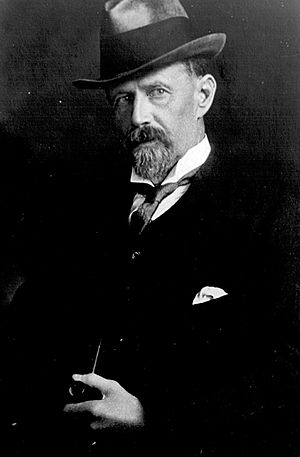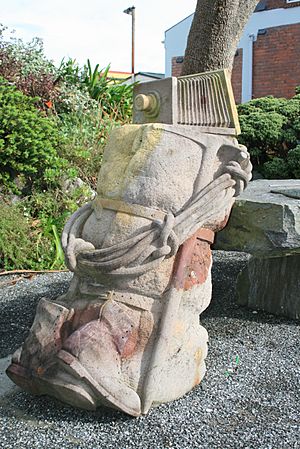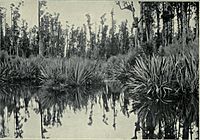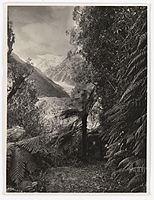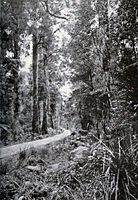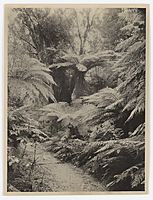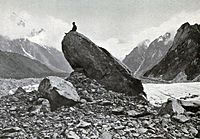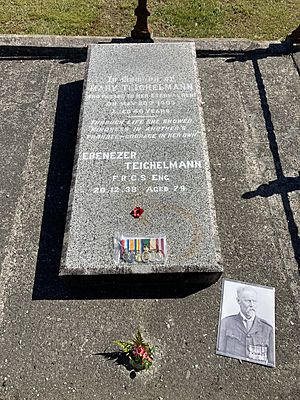Ebenezer Teichelmann facts for kids
Quick facts for kids
Ebenezer Teichelmann
FRCS
|
|
|---|---|
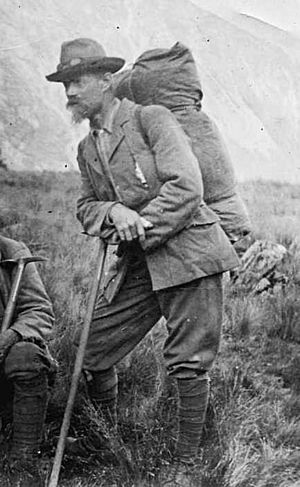
Teichelmann in 1905 (aged around 46)
|
|
| Born | 23 March 1859 |
| Died | 20 December 1938 (aged 79) Hokitika, New Zealand
|
| Resting place | Hokitika Cemetery |
| Monuments | Teichelmann Memorial, Hokitika Mt Teichelmann Teichelmann Peak Teichelmann Rock Teichelmann Creek Teichelmann's corner Teichelmann's Track Ebenezer Peak |
| Alma mater | University of Adelaide |
| Occupation | surgeon, mountaineer, explorer, conservationist, photographer |
| Parent(s) |
|
Ebenezer Teichelmann (born March 23, 1859 – died December 20, 1938) was a famous doctor, mountain climber, explorer, and photographer in New Zealand. His friends often called him 'the little Doctor'. He was born in Australia but spent most of his life in New Zealand.
He was a brave man who even survived a shipwreck during World War I! He was the first to climb 26 mountains and cross seven mountain passes. He helped make mountain climbing popular again in New Zealand when it was almost forgotten. He loved photography and carried a heavy camera up many mountains. His amazing photos helped protect beautiful places in New Zealand.
Contents
Growing Up and Becoming a Doctor
Early Life in Australia
Ebenezer Teichelmann was born on March 23, 1859, in South Australia. He was one of 15 children! His father, Christian Teichelmann, was a German missionary, and his mother, Margaret, was from Scotland. The family lived on a farm called Ebenezer.
They didn't have much money, so only Ebenezer could go to high school. He went to Hahndorf College.
Becoming a Surgeon
After finishing school, Ebenezer moved to Adelaide. He started working as an apprentice for a pharmacist. This means he learned how to prepare medicines. After his apprenticeship, he worked as a chemist for a doctor while studying medicine at the University of Adelaide.
In 1882, Teichelmann traveled to England and Ireland to continue his medical studies. He specialized in surgery. He worked in several hospitals, gaining lots of experience. He even worked for a famous surgeon named Lawson Tait. During his ten years in England, he became a highly skilled surgeon.
In England, he met Mary Bettney, who was a matron (a head nurse) at a hospital. They got married in 1891.
Moving Back to Australia
In 1892, the Teichelmanns returned to Australia. Ebenezer worked as a ship's doctor on the way. Back in Adelaide, he became a health officer and later a surgeon in the military. He also filled in for a professor at Adelaide University.
However, there were problems at the Adelaide hospital. Many doctors left their jobs. When Ebenezer was offered a top surgeon position, he turned it down. He didn't want to go against his fellow doctors. He decided it was time for a new adventure.
Life in New Zealand
A Doctor in Hokitika
In 1897, Dr. Teichelmann and Mary moved to Hokitika, a town on the West Coast of New Zealand's South Island. He became the main surgeon at the Westland Hospital. This was a big job because he was the only doctor for many miles!
He had to be a great surgeon and a good manager. The hospital cared for many different patients. He also had a private practice at his home, where a nurse and housekeeper helped him. Nurse Bess Hudson was a great help to him for many years.
Traveling for Patients
Hokitika was a wild and rugged area. Dr. Teichelmann often had to travel long distances, day or night, to reach his patients. Roads were often just tracks, and rivers had no bridges. Accidents were common, especially with mining and logging.
Once, he and Nurse Hudson even used a railway cart to travel 10 kilometres (6.2 mi) at night to help a patient!
Mary Teichelmann
Mary Teichelmann quickly became well-known in Hokitika. She was a modern woman for her time. She was the first woman in town to smoke in public, play golf, and one of the first to drive a car. She also helped the hospital by raising money for an invalid chair.
Sadly, Mary became ill and died suddenly in 1909 at age 46. The whole town was very sad about her unexpected death.
A Trip to Europe
In 1912, Dr. Teichelmann decided to take a break to update his medical skills. He felt a bit isolated in New Zealand. He planned to spend several months observing doctors in big hospitals in Europe. He also wanted to go climbing in the Swiss Alps.
The town of Hokitika gave him a big farewell party. He traveled to cities like Birmingham, Vienna, and Paris. He also climbed in Zermatt and attended a big medical conference. When he returned in 1913, he was amazed by the new motor cars in London and the progress in aviation.
War Service
Serving in World War I
When World War I started in 1914, Dr. Teichelmann wanted to serve. He was already a Surgeon Major in the New Zealand Medical Corps. At first, he wasn't called up, possibly because of his German last name. But he kept asking to serve.
Finally, in August 1915, he joined the Medical Corps. He sailed to Egypt and joined a hospital there. Soon after, his hospital was told to move. Dr. Teichelmann boarded a troopship called the SS Marquette. There were also 36 New Zealand nurses on board.
Shipwreck Survival
Four days later, the Marquette was hit by a torpedo and sank in just seven minutes! Many people died in the explosion or by drowning. Dr. Teichelmann spent several hours in the water before he was rescued.
The hospital was set up again in Greece. They treated many soldiers from the front lines. Dr. Teichelmann, with his mountain experience, was very good at treating severe frostbite injuries. Later, he moved to a hospital in France.
Facing Challenges at Home
During the war, some people in New Zealand were suspicious of anyone with a German name. Dr. Teichelmann's name was even put on a list of "German suspects" in Parliament. But the Mayor of Hokitika strongly defended him, saying Dr. Teichelmann was a respected citizen who had served his town for 20 years.
Dr. Teichelmann returned to New Zealand in December 1916 on a hospital ship. He continued to work as a doctor, including at the Seaview Asylum.
The Spanish Flu Epidemic
In 1918, the terrible influenza epidemic reached Hokitika. Dr. Teichelmann worked tirelessly. He opened extra beds in schools and club rooms because the hospital was full. Many nurses and even a medical student helping him got sick. Four nurses died. In less than three weeks, 27 people in Hokitika died from the flu.
Exploring and Mountain Climbing
A Passion for Mountains
Between 1899 and 1924, Dr. Teichelmann made 26 first ascents of mountains. He also made seven first crossings of mountain passes. He is famous for helping to restart mountain climbing in New Zealand when it was almost gone.
His love for mountains started when he got involved in gold-mining. In 1899, he joined a group looking for gold. He wanted to take photos of their trip. He carried his heavy camera up the mountains. Even though they didn't find gold, the 40-year-old doctor fell in love with the mountains. He spent the next 25 years exploring the mountains of South Westland.
The "Little Doctor" on the Mountains
Dr. Teichelmann was known as "the little Doctor" because he was small. But he had amazing physical strength! When he climbed Douglas Peak in 1907, he and his companions carried over 25 kilograms (55 lb) of camera equipment. His friends sometimes complained about carrying his heavy camera, but they always loved seeing the photos afterward. He even protected his camera before himself if there wasn't enough space for both!
As a surgeon, he always worried about hurting his hands. Before climbing on rocks, he would tape his hands to prevent cuts that might stop him from operating.
Famous Climbing Partners
Dr. Teichelmann often climbed with Canon Henry E Newton and Alex Graham. Many people believe they were the "greatest climbing trio" in New Zealand's history. Newton was a vicar (a type of priest) who loved mountaineering. Alex Graham was a skilled local guide.
Dr. Teichelmann was elected to the London Alpine Society in 1903. He became the President of the New Zealand Alpine Club in 1936 and was given a special Life Membership in 1937.
Photography and Conservation
Capturing New Zealand's Beauty
It's not clear how Dr. Teichelmann learned photography, but he was very good at it. He used a large camera that took pictures on glass plates. Even though it was heavy, he carried it up many mountains. He would often develop his photos in a friend's bathroom! He also worked with a professional photographer in Hokitika to print his pictures.
He built a huge collection of photos of New Zealand's scenery. He tried to take wide, panoramic views, which helped map the area. His photos were used in books, government reports, and tourism brochures. People said his photos helped show the beauty of Westland to the whole world.
Inspiring Others
In 1907, Dr. Teichelmann met Alfred A. Longden, a director of fine arts from Britain. Longden was also a mountaineer. Dr. Teichelmann had many of his photos displayed at an exhibition in Christchurch. Will Kennedy, the President of the New Zealand Alpine Club, was so impressed by his photos that he wanted to meet the man who took them. They became close friends.
A famous Australian climber named Freda Du Faur first saw photos of the Southern Alps at this exhibition. Dr. Teichelmann later let her use some of his photos in her book about climbing Mount Cook.
Protecting Nature
Dr. Teichelmann's photographs made people more aware of the beautiful scenery in Westland. His photos helped turn places like Lake Kaniere, Punakaiki, and Arthur's Pass into protected scenic reserves.
He was also interested in plants and became friends with a botanist (plant expert) named Leonard Cockayne. They wrote reports together about native plants. Dr. Teichelmann was a key person in setting up a board to protect the Lake Kaniere Scenic Reserve in 1934. This board worked to clear invasive plants and control pests that harmed native birds.
Later Life and Legacy
Final Years
In 1934, Dr. Teichelmann's old climbing friend, Newton, visited him. He noticed Dr. Teichelmann had a jaw problem, but he was still very interested in mountains. Dr. Teichelmann planned to visit England again, but he died on December 20, 1938, in Hokitika, at the age of 79.
He is buried with his wife, Mary, in Hokitika Cemetery.
Remembering Dr. Teichelmann
Dr. Teichelmann's old house and surgery at 20 Hamilton Street in Hokitika is now a bed and breakfast called "Teichelmann's Bed and Breakfast." In 2000, a memorial stone bench and sculpture were put up across from his house. It shows his climbing gear, like his pack, ropes, and camera.
Many places in New Zealand are named after him, including Mount Teichelmann, Teichelmann Peak, Teichelmann Rock, Teichelmann Creek, Teichelmann's Corner, Teichelmann's Track, and Ebenezer Peak.
More than 600 of Dr. Teichelmann's photographs and negatives are kept at the University of Canterbury.
A book about Dr. Teichelmann was published in 2007. Sir Edmund Hillary, the first person to climb Mount Everest, wrote the foreword. He said that Dr. Teichelmann's climbs and explorations were "remarkable" for his time. A TV show called First Crossings even recreated his difficult crossing of the Cook River Gorge in 1905.


